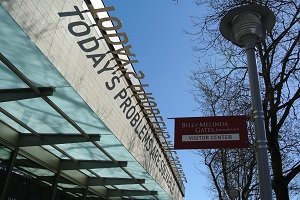 In the beginning of 2015, Bill Gates made a blog entry, in which he has visited a special facility of The Gates Foundation ownership. It was a huge machine that turns human waste into drinking water and electricity. The facility is designed to improve the sanitary conditions in less developed countries, rather than providing people with drinking water. Nevertheless, everyone who tasted water that was produced by Omniprocessor reported its good quality. The facility itself was successfully launched in Senegal later that year.
In the beginning of 2015, Bill Gates made a blog entry, in which he has visited a special facility of The Gates Foundation ownership. It was a huge machine that turns human waste into drinking water and electricity. The facility is designed to improve the sanitary conditions in less developed countries, rather than providing people with drinking water. Nevertheless, everyone who tasted water that was produced by Omniprocessor reported its good quality. The facility itself was successfully launched in Senegal later that year.
The statistics are unpleasantly surprising. In the present-day world, over 2 billion people—this is more than one fourth of the global population—have no access to sewage systems that are properly functioning. Latrines without regular drainage lead to poor sanitary conditions which result into various diseases and even cause deaths. Every year, thousands or even millions of children suffer from developmental problems, and 700,000 die because of poor sanitation. In Dakar, where the first Omniprocessor was tested, 1.2 million people do not have access to the sewage system. Because the problem cannot be easily fixed by building the necessary infrastructure, people are searching for alternative options.
To change the situation with sanitation in Dakar, and avoid the necessity to construct an entirely new sewage system, the Omniprocessor project was launched. Its goal is to improve the quality of life for the Dakar population. The machine was built by engineers from a small company Janicki Bioenergy which is based in the Seattle area. The Gates Foundation funded the company’s Omniprocessor in 2013 and made it a part of “Reinvent the Toilet Challenge”, an initiative by the foundation.
It is as big as two buses and consists of a steam engine, an incinerator, and a water purification system. It is extremely powerful too. The waste is burned at a temperature of 1,000 degrees, which ensures that there is no smell, and the process itself complies with all the US standards regarding emissions. It is also energy-efficient: through the use of steam engine, it generates not only enough energy for another cycle, but also sufficient to produce electricity. One Omniprocessor unit is capable of burning 14 tons of waste (or waste of 100,000 people), provides 250kw of electricity each day and 86,000 liters of fresh water.
In February 2015, the first Omniprocessor machine was transported to Dakar in Senegal. It was not clear whether the project will succeed or not, but it did. In May of the same year the facility was fully functional. It should be mentioned that the city of Dakar has its drainage system. What is also good, $1.5 million for the Omniprocessor is a reasonable price to pay, especially since people’s health and even lives are at stake, and the alternatives are hundreds of times more expensive. Currently, the developers are looking for a more efficient machine; for example the one which would burn all kinds of garbage and waste turning them into water and electricity.
References
- Deshusses, M. Neighborhood-scale treatment of fecal sludge by supercritical oxidation – Various documents on results from research grant. Duke University, Durham, NC, 2013.
- Franceys R, Gerlach E. Regulating Water and Sanitation for the Poor: Economic Regulation for Public and Private Partnerships. Earthscan, 2012.
- Frederick, R, Gurski, T. Synapse Dewatering Investigation Report – Omni-Ingestor Phase 2, Milestone 1. Consultancy report by Synapse (USA) commissioned by Bill & Melinda Gates Foundation, Seattle, USA, 2012.
- Kuchenrither, RD, Stone L, Haug RT. Omni-Processor Landscaping Project. Consultancy report by WERF, Seattle, USA, 2012.
- “Oya project – community waste treatment”. Unilever, UK, 2015.
- Reinvent the Toilet Challenge. Bill & Melinda Gates Foundation, 2015.
Radke, N, Spuhler, D. Brief overview of conditions for water, sanitation and hygiene grants by the Bill & Melinda Gates Foundation, 2013.
